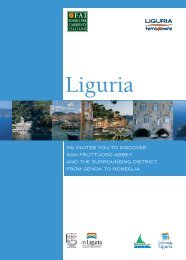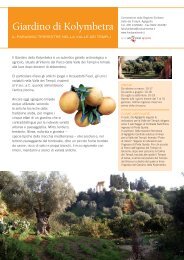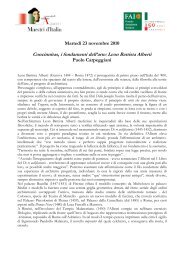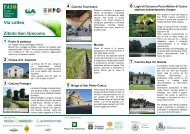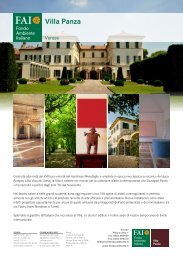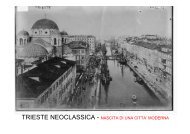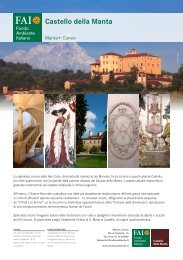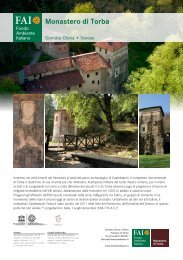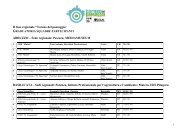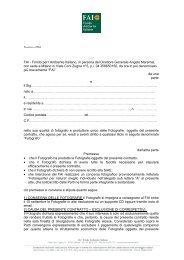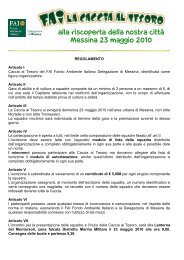Annual Report 2011 - Fai
Annual Report 2011 - Fai
Annual Report 2011 - Fai
You also want an ePaper? Increase the reach of your titles
YUMPU automatically turns print PDFs into web optimized ePapers that Google loves.
1. Protecting and enhancing<br />
Restoration<br />
Tutelare e valorizzare<br />
Restauro<br />
© A. Angelucci<br />
© A. Angelucci<br />
THE BOSCO DI SAN FRANCESCO, A JOURNEY OF DISCOVERY THROUGH THE<br />
LANDSCAPES OF ST FRANCIS<br />
On 11 November <strong>2011</strong>, after more than a year of work, the Bosco di San Francesco was<br />
officially opened to the public . The objective of the restoration and re-landscaping<br />
project was to offer visitors the possibility of undertaking a real interior journey to discover<br />
the message of perfect harmony between Man and Nature that Saint Francis sent<br />
out to the world, starting from right here. In the first phase, we reinstated and made safe<br />
the paths and dealt with the overhaul of the landscape in the areas at the edges of the<br />
paths, followed by the bedding out of 200 new olive trees, high-trunked trees and<br />
around a thousand shrubs. The most challenging aspect, however, concerned the Santa<br />
Croce Complex, a microcosm – inhabited in the late 13th/early 14th century by Benedictine<br />
monks – that encompasses a church, a mill, the remains of a hospice and of a monastery, and<br />
further away, an ancient tower-cum-manufactory. Thanks to a complicated array of operations,<br />
which involved a plethora of different professionals, we managed to complete a conservative<br />
restoration of the buildings – an operation that has seen them become functional<br />
once again. The rooms of the presbytery have been refurbished as a reception and<br />
information point for visitors, complete with a bookshop and an educational exhibition,<br />
whereas the Mill has been renovated to provide catering facilities for visitors to the Bosco<br />
di San Francesco. In the Hospice area, figs, walnuts and other fruit trees have been<br />
used to redesign the internal terraces to evoke the lost garden of the Benedictine monks,<br />
whereas the ancient Annamaria Tower has had its masonry consolidated and has<br />
been fitted with a new iron staircase to allow access to the roof, in order to afford visitors a<br />
panoramic view over the clearing of the Terzo Paradiso (Third Paradise).<br />
THE RESTORATION AND<br />
ENHANCEMENT OF THE BOSCO<br />
DI SAN FRANCESCO<br />
50,000<br />
m² of woodland overhauled<br />
1,000<br />
shrubs<br />
140<br />
abandoned olive trees<br />
given a new lease of life<br />
200<br />
new olive trees planted<br />
3.5<br />
km of paths upgraded<br />
1,720<br />
m 2 of rebuilding using<br />
recovered stone<br />
THE RESTORATION OF THE BENEDICTINE COMPLEX OF SANTA CROCE<br />
15,000<br />
pieces of stone used<br />
for the reconstruction<br />
of the dry-stone walls<br />
of the olive groves<br />
21,000<br />
man-hours of work devoted<br />
to the restoration of the<br />
Santa Croce complex<br />
520 430<br />
man-hours of work on the man-hours dedicated to the<br />
archaeological excavations restoration of the fresco in<br />
for the hospice and the the Church of Santa Croce<br />
Annamaria tower<br />
30<br />
tonnes of waste and<br />
362<br />
tyres removed<br />
28 <strong>Annual</strong> <strong>Report</strong> <strong>2011</strong> <strong>Annual</strong> <strong>Report</strong> <strong>2011</strong> 29




